Related Research Articles

The Willamette Valley AVA is an American Viticultural Area which lies in the Willamette Valley of Oregon. The AVA is the wine growing region which encompasses the drainage basin of the Willamette River. It stretches from the Columbia River in the north to just south of Eugene in the south, where the Willamette Valley ends; and from the Oregon Coast Range in the west to the Cascade Mountains in the east. At 5,360 square miles (13,900 km2), it is the largest AVA in the state, and contains most of the state's wineries; approximately 908 as of 2021.

The Southern Oregon AVA is an American Viticultural Area which lies in Southern Oregon, United States. The Southern Oregon AVA was established in 2005 and was created to include the land of two smaller AVAs: the Rogue Valley AVA and the Umpqua Valley AVA. Southern Oregon AVA was established to allow the two principal winegrowing regions in the southern part of the state to market themselves jointly. This creation of a "super-AVA" is a departure from the trend in the Willamette Valley AVA or northern Oregon of establishing smaller AVAs specific to a particular locale's climate or soil conditions.

The Yamhill-Carlton AVA is an American Viticultural Area located in both Washington County and Yamhill County, Oregon. It is entirely contained within the Willamette Valley AVA, and surrounds the towns of Carlton and Yamhill. The mountain ridges surrounding the AVA form a horseshoe shape, and most of the vineyards are located on south-facing slopes. The AVA includes only land between 200 feet (61 m) and 1,000 feet (305 m) above sea level where marine sediments are some of the oldest soils in the Willamette Valley and create unique conditions for viticulture. The region is in the rain shadow of the 3,500 feet (1,100 m) Oregon Coast Range, a short distance to the west.

The Horse Heaven Hills AVA is an American Viticultural Area in southeastern Washington, and is part of the larger Columbia Valley AVA. The Horse Heaven Hills AVA borders the Yakima Valley AVA on the north and the Columbia River on the south. Elevations in this AVA range from 200 feet (61 m) above sea level in the south to 1,800 feet (549 m) above sea level at the northern boundary. Grapes planted in the south-facing slopes of the Horse Heaven Hills benefit from strong winds that arrive from the west via the Columbia Gorge, reducing the likelihood of rot and fungal diseases.
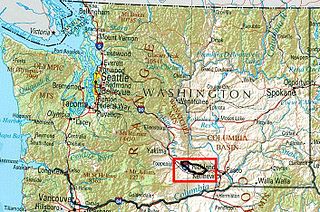
The Rattlesnake Hills AVA is an American Viticultural Area located in Yakima County, Washington. United States Alcohol and Tobacco Tax and Trade Bureau (TTB) awarded Rattlesnake Hills its appellation status on March 20, 2006, making Rattlesnake Hills Washington's ninth federally recognized American Viticultural Area. The Rattlesnake Hills AVA is entirely contained within the Yakima Valley AVA, which is in turn is entirely contained within the larger Columbia Valley AVA. The hills form the northern boundary of Yakima Valley, and the AVA includes land between the north bank of the Sunnyside Canal and the entirety of the southern slopes of the Rattlesnake Hills between Outlook and the Wapato Dam. The AVA is centered on the city of Zillah. With elevations ranging from 850 feet (259 m) to 3,085 feet (940 m), this AVA contains the highest point in the Yakima Valley AVA.

Santa Maria Valley is an American Viticultural Area (AVA) which straddles the boundary of Santa Barbara and San Luis Obispo counties in California's multi-county Central Coast AVA. It was established on August 5, 1981, by the Bureau of Alcohol, Tobacco, Firearms and Explosives (ATF) as California's second oldest AVA. A portion of the AVA crosses the Cuyama River into the southernmost corner of San Luis Obispo County. The east–west orientation of the 152.3 square miles with a wide, open valley and rolling hills means cool winds and fog flow in freely from the Pacific Ocean, settling most noticeably in lower-lying areas. The result is a mild Mediterranean climate that lengthens the growing season and contributes to the eventual sugar/acid balance in the grapes from Santa Maria Valley's 7,500 acres (3,000 ha) cultivated vineyards. On January 28, 2011, the AVA was granted an 29.4 square miles expansion to its southern boundary.

The Snake River Valley is a American Viticultural Area (AVA) that encompasses an area in Southwestern Idaho and two counties in eastern Oregon. The Idaho Grape Growers and Wine Producers Commission and the Idaho Department of Commerce and Labor filed the petition to recognize the AVA, and it was granted in 2007.
Monticello is an American Viticultural Area (AVA) located in the central Piedmont region of the Commonwealth of Virginia. It was established by the Bureau of Alcohol, Tobacco and Firearms (ATF) on February 22, 1984 after six wine grape growers in the Charlottesville area petitioned the ATF to designate a viticultural area to be known as “Monticello.” The name "Monticello" is known nationally and locally as the historic home of Thomas Jefferson, located near the center of the area. Monticello AVA includes most of Albemarle, Fluvanna, Greene, Orange, and Nelson counties. The area is nestled along the eastern slopes of the Blue Ridge Mountains and encompasses the small ridge known as the Southwest Mountains. There are approximately 30 varieties of grapes grown in the Monticello AVA. However, the most notable grapes grown in the area include Cabernet Franc, Chardonnay and Viognier. The hardiness zone is 7a except in some higher vineyards which are 6b. In 2019, the Tax and Trade Bureau (TTB) granted a petition to expand the AVA by approximately 106,240 acres (166 sq mi) into Fluvanna County.
The North Fork of Roanoke AVA is an American Viticultural Area located on the eastern slopes of the Allegheny Mountains in the Roanoke and Montgomery counties of Virginia. About 22 miles (35 km) long and including parts of the Roanoke Valley, the AVA altitudes range from between 1,200 feet (366 m) and 2,200 feet (671 m) above sea level.
The Santa Cruz Mountains AVA is an American Viticultural Area centered on the Santa Cruz Mountains. Its territory spans three California counties, Santa Clara, Santa Cruz and San Mateo. Established in 1981 by the Alcohol and Tobacco Tax and Trade Bureau (TTB), Santa Cruz Mountains AVA was among the first to be defined by its mountain topography. Based on elevation, it largely follows the fog line along the coast, extending down to 800 feet (240 m) on the eastern slope toward San Francisco Bay, 400 feet (120 m) on the western slope to the Pacific Ocean and extending toward the ridgecrests at 3000+ feet elevation.
The Potter Valley AVA is an American Viticultural Area located in northern Mendocino County, California, with its center in the town of Potter Valley. This appellation is located to the east of the Redwood Valley AVA and sits at an elevation approximately 200 feet (61 m) higher than the surrounding areas. The proximity to the nearby Eel River watershed has created favorable conditions for the production of botrytized wines, particularly Riesling, Sauvignon blanc, and Semillon.

The Howell Mountain AVA is an American Viticultural Area located within Napa Valley AVA of California.
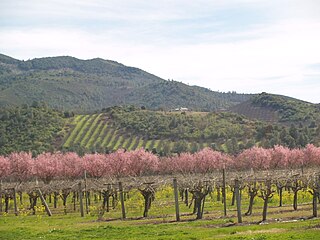
Lake County wine is a appellation that designates wine made from grapes grown mostly in Lake County, California and located north of Napa County. Although each region within Lake County has unique viticultural attributes, all are influenced by Clear Lake, the largest inland body of water in California. County names in the United States automatically qualify as legal appellations of origin for wine produced from grapes grown in that county and do not require registration with the Alcohol and Tobacco Tax and Trade Bureau (TTB). TTB was created in January 2003, when the Bureau of Alcohol, Tobacco and Firearms, or ATF, was extensively reorganized under the provisions of the Homeland Security Act of 2002.
Mt. Harlan is an American Viticultural Area (AVA) located in San Benito County, California. It was established on December 17, 1990 by the Bureau of Alcohol, Tobacco and Firearms (ATF) within California’s multi-county Central Coast AVA. It lies within the Gabilan Mountains at elevations of 1,800 feet (550 m) to 2,200 feet (670 m) above sea level where the soil is predominantly limestone. The AVA was established as the result of a petition to the ATF by Josh Jensen and the Calera Wine Company, the only commercial winery in the appellation at the time.
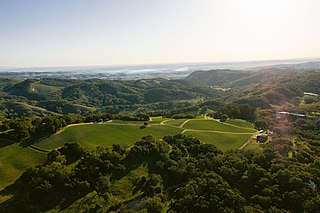
York Mountain is an American Viticultural Area (AVA) in San Luis Obispo (SLO) County, California. It lies within the larger Central Coast AVA located on the eastern side of the Santa Lucia Mountains and west of Paso Robles viticultural area. The mountainous terrain features vineyards that are mostly cultivated at an elevation around 1,500 feet (460 m). York Mountain climate is cooler and wetter than Paso Robles being just 8 miles (13 km) from the Pacific Ocean. York Mountain viticultural area was recognized as the county’s second AVA by the Bureau of Alcohol, Tobacco and Firearms (ATF) effective on September 23, 1983 after reviewing the petition submitted by Stephen and Max Goldman, owners of York Mountain Winery, to establish a area known as “York Mountain.” Historically, Andrew York, a British immigrant, planted the first vineyard on York Mountain in the 1870s and established Ascension Winery, the first bonded winery in the Central Coast. It survived through Prohibtion and later renamed York Mountain Winery, staying in the York family until 1970 when it was purchased by Max Goldman.
The Mimbres Valley AVA is an American Viticultural Area located in southwestern New Mexico near the towns of Deming and Silver City. The AVA includes the Mimbres Watershed of the Mimbres River, and most vineyards are planted at elevations between 4,000 feet (1,200 m) and 6,000 feet (1,800 m) above sea level. The area is a desert, but irrigation and the deep, rich soils of the once-larger Mimbres River have made viticulture possible since the late 19th century.
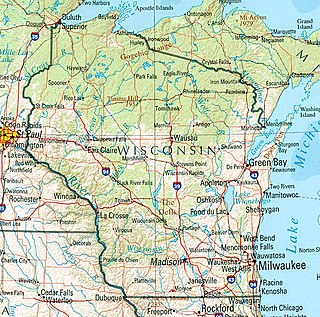
The Lake Wisconsin AVA is an American Viticultural Area located in south central Wisconsin. The wine growing region borders both Lake Wisconsin and the Wisconsin River. The first grapes were planted in the area by Agoston Haraszthy in 1847, before he migrated to California. Most vineyards in the area are planted at elevations between 800 feet (240 m) and 900 feet (270 m) above sea level. The area soils are gravel and sandy loam from glacial deposits. French hybrid grapes have had the most success in the Lake Wisconsin area, and the most important grape varietal grown in the area is Marechal Foch.
Snipes Mountain AVA is an American Viticultural Area located in the Yakima Valley of Washington State. It was approved by the Bureau of Alcohol, Tobacco, Firearms and Explosives on January 21, 2009 making it Washington's 10th federally designated AVA. It is the second smallest AVA in the state, after the Red Mountain AVA, and has one of the state's longest viticultural histories. The 4,145 acres (1,677 ha) appellation is a sub-AVA of the Yakima Valley AVA and the Columbia Valley AVA. It is located above and between the towns of Sunnyside and Granger around Outlook, Washington, in the southeast corner of the Yakima Valley.
Eagle Foothills AVA is the second Idaho American Viticultural Area located in the southwestern part of the state, north of Boise, and a sub-region within the vast Snake River Valley AVA. It is the first appellation in Idaho. The region encompasses 49,815 acres (20,159 ha) and nearly 70 acres (28 ha) of grapes planted when established with plans to add 472 acres (191 ha) of vineyards. The region is located in hardiness zones 7a and 7b. Vineyard elevations are approximately below 2,000 feet.
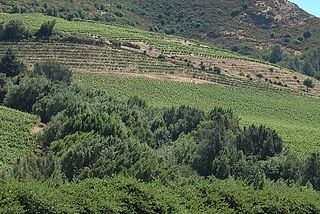
Moon Mountain District Sonoma County is an American Viticultural Area (AVA) within Sonoma Valley and North Coast viticultural areas, just north of the city of Sonoma. This mountainous region on the very eastern edge of Sonoma County has a historic reputation for producing rich, intensely-flavored wines from Cabernet Sauvignon and Syrah varietals since the 1880s. The District was established on November 1, 2013, by the Alcohol and Tobacco Tax and Trade Bureau (TTB). Its designation covers 17,663 acres (28 sq mi) of land stretching north-south along the western slopes of the Mayacamas mountains between Sugarloaf Ridge State Park and Los Carneros viticultural area with the Napa Valley’s Mount Veeder viticultural area outlining the eastern slopes. Its name is derived from Moon Mountain Road, which traverses through the area and itself a reference to Sonoma, which means 'valley of the moon' in the local Native American dialect. A clear view to San Francisco 50 miles (80 km) south is not uncommon from Moon Mountain District vineyards.
References
- ↑ "§ 9.43 Rocky Knob" (Title 27: Alcohol, Tobacco and Firearms; Part 9 — American Viticultural Areas; Subpart C — Approved American Viticultural Areas). Code of Federal Regulations. (e-CFR). February 12, 2012. Retrieved January 31, 2008.
- ↑ "American Viticultural Areas by State". Wine Institute. 2008. Archived from the original on January 27, 2008.
- ↑ "Rocky Knob (AVA): Appellation Profile". Appellation America. 2007. Archived from the original on September 12, 2013. Retrieved January 31, 2008.
- 1 2 "Rocky Knob Wine". Wine Searcher.